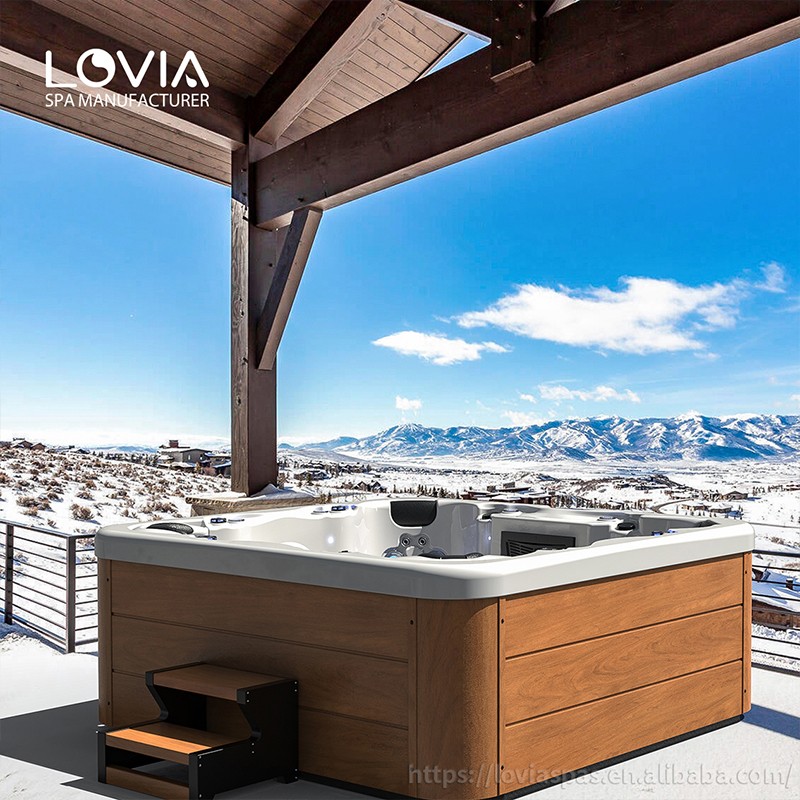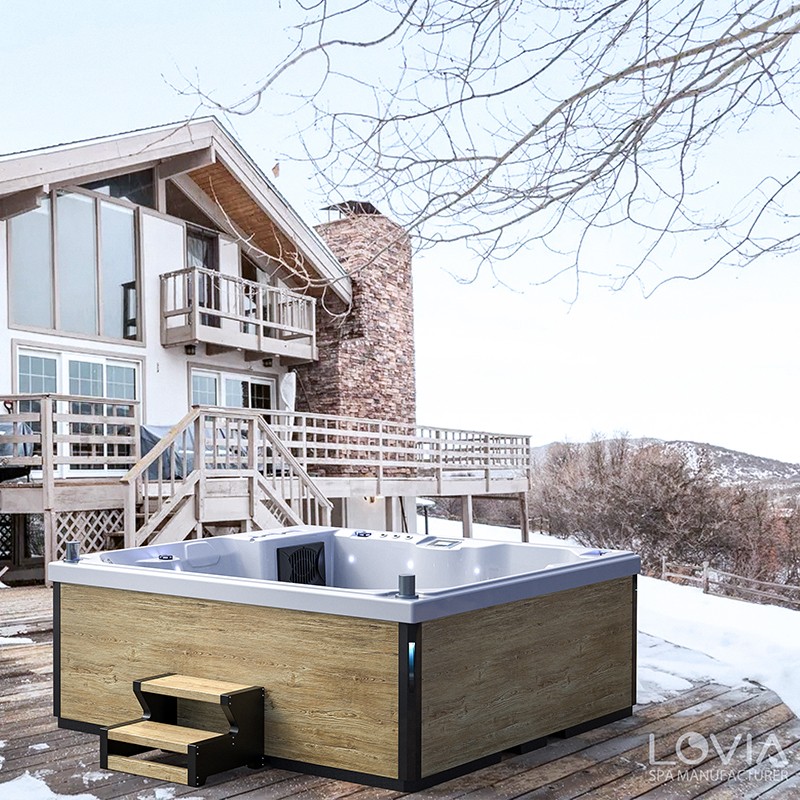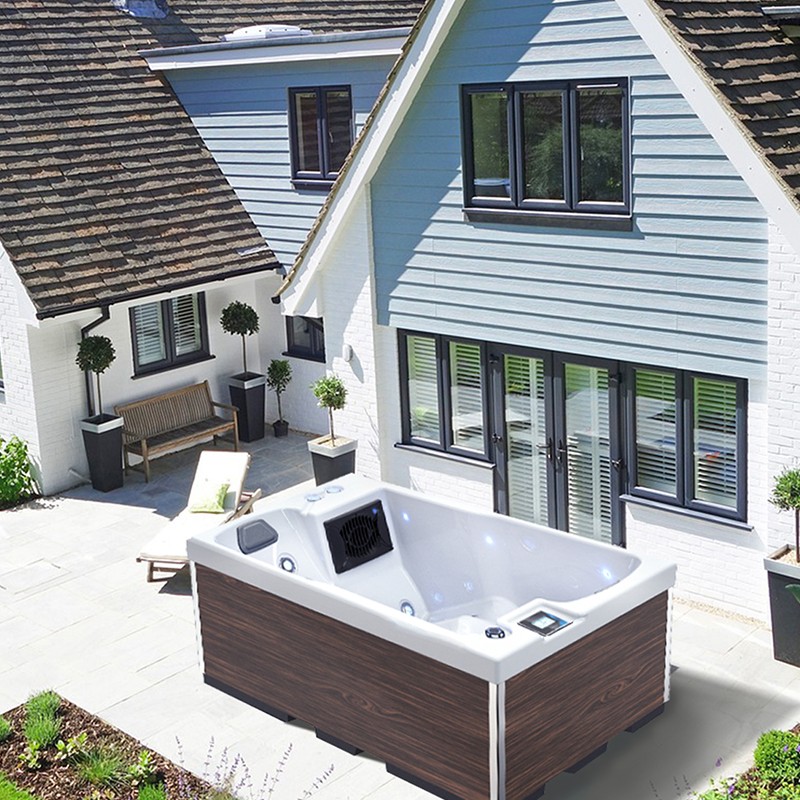
Will a plug-and-play hot tub work outdoors in the winter?
2024-11-09 15:35As temperatures drop, many hot bathtub enthusiasts are concerned about whether their units will survive the cold winter months. Especially for "plug-and-play" hot tubs, which are easy to install and powered by a standard electrical outlet, their ability to withstand cold weather and their safety during winter months have become a common concern. So, will a plug-and-play hot bathtub work outdoors in the winter?
This article will explore this question in detail and help users better understand how to safely use a plug-and-play hot bathtub in cold weather.

How does a plug-and-play hot tub work?
First, in order to better answer the question "will a plug-and-play hot tub work outdoors in the winter", we need to understand how it works.
The biggest difference between plug-and-play hot tubs and traditional hot tubs is that they are powered by a 110V or 120V power supply instead of the usual 220V high-voltage power supply. This means that plug-and-play hot tubs have a smaller heater, usually around 1500 watts. The design is intended to simplify installation, allowing the tub to be powered by a regular household outlet, so users can simply plug the tub into the outlet and use it.
Due to the limited power of the plug-and-play tub's heating system, it heats up relatively slowly, especially in cold environments where it takes longer to raise the water temperature to a level suitable for soaking.

Can plug-and-play hot tubs be used outdoors in the winter?
There are several obvious challenges to using a plug-and-play hot tub in the winter, especially when the temperature drops below freezing.
Slow Heating
The relatively low power of the plug-and-play hot tub's heater means that the water will heat up more slowly in cold environments. Especially when the outdoor temperature is near or below freezing, the tub will take more time to heat the water to the ideal temperature. In some extreme weather conditions, the heater may have difficulty keeping the water temperature within a comfortable range. This may cause users to wait longer to enjoy the warm effects of the tub.
Insulation Limitations
Insulation is another key issue when using a hot bathtub in the winter. Plug-and-play hot bathtubs are usually slightly lacking in insulation due to their simple design. Cold winter air can quickly remove heat from the surface of the tub and parts that are not adequately insulated, causing the water temperature to drop rapidly. Even if the heater is constantly working, it may not be able to make up for the lost heat, and the water temperature will become too cold in a short period of time, affecting the user experience.
In addition, low temperatures increase the workload of the heater, which increases energy consumption and shortens the life of the device.
Antifreeze issues
In extremely cold conditions, especially in temperatures below freezing, the pipes and water pumps of outdoor hot tubs are prone to freezing. If the water freezes in the pipes, it will cause the device to not work properly and may even damage important components such as the pump or heater. Plug-and-play hot tubs usually do not have a dedicated antifreeze mechanism, so special attention needs to be paid to prevent the pipes from freezing.
In addition, freezing can also affect the normal circulation of water flow, causing the system to overload or shut down, which in turn causes serious damage to the device. If effective preventive measures are not taken, the freezing problem will affect the safety and service life of the device.

How to ensure that plug-and-play hot tubs operate normally outdoors in winter?
Although plug-and-play hot tubs face certain challenges when using them in winter, they can still operate safely in cold outdoor environments if users take appropriate measures. Here are some key measures to help users maximize the winter use of plug-and-play hot tubs.
Ensure good insulation
To address the problem of rapid water temperature drops, users can improve the insulation of their hot bathtubs. Some specific measures include:
● Use a bathtub cover: A high-quality hot tub cover can effectively prevent heat from escaping from the water surface. When not in use, a good cover can not only save energy but also maintain water temperature.
● Insulate the bottom and sides of the bathtub: Use professional insulation materials to insulate the bottom and sides of the bathtub. These materials can effectively reduce the heat loss through the bathtub shell and ensure that the water temperature can be kept as stable as possible.
Use a thermostat and timer
To better control the water temperature in cold environments, users can use a thermostat and timer. The thermostat can automatically adjust the bathtub's heater power to ensure that the water temperature remains within the user's set comfort range. The timer can help users control the working hours of the heater to avoid the heater from running ineffectively for a long time and save electricity.
Some advanced plug-and-play hot bathtubs also come with smart temperature control features that automatically adjust the heating mode based on changes in outside temperature, further improving the convenience of winter use.
Check the status of pipes and pumps regularly
During the winter, it is very important to ensure that the hot tub's pump and pipes are in working order. Regularly checking the pipes for ice and ensuring that the water flows smoothly is key to avoiding equipment failure. Users can also consider keeping the hot tub's pump running at a low speed during cold weather to keep the water circulating and prevent the pipes from freezing.
Other measures to prevent pipe freezing
In extremely low temperature environments, users can take additional anti-freeze measures. For example, a special pipe heater can be used to keep the water flowing in the pipes to prevent freezing. In addition, in extremely cold weather, try not to completely shut down the bath system, but keep the pump running at a low speed to maintain water circulation, which can effectively reduce the risk of freezing.
Choose a plug-and-play hot tub for winter use
Not all plug-and-play hot bathtubs are suitable for use in extremely cold environments. Therefore, when choosing a hot tub, users should give priority to models that are designed with special attention to thermal insulation and winter use. These bathtubs usually have better insulation design, powerful heaters and cold-resistant materials to work properly in cold winter environments.
Some brands also offer plug-and-play bathtubs equipped with anti-freeze devices, which can automatically start in cold weather to keep the water flowing smoothly and prevent pipes and water pumps from freezing.

What are the precautions for using plug-and-play hot tubs in winter?
Although plug-and-play hot tubs can be used in winter, users should pay attention to some details when actually operating to ensure safe use and equipment life.
Safe use of electricity
Because plug-and-play hot tubs rely on household power, it is important to pay special attention to electrical safety when using them in winter. Make sure the power socket of the bathtub is waterproof and well grounded. Using waterproof sockets or plugs designed specifically for outdoor use can prevent short circuits or failures in the power system due to rain and snow.
Keep the equipment dry
In snowy or humid environments, it is very important to keep the area around the bathtub dry. If snow or rain enters the circuit system, it may cause a short circuit or damage to the equipment. Therefore, users should always keep the bathtub and power area dry when using hot bathtubs in winter to prevent moisture intrusion.
Timely maintenance
Winter is the peak season for hot bathtub equipment failures, so users need to regularly check the various components of the tub, including the heater, water pump, pipes and control system. If any abnormality is found, it should be repaired or replaced in time to avoid the problem from expanding.
